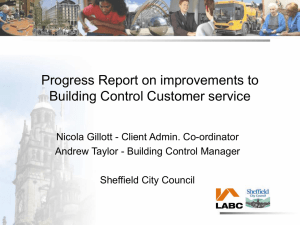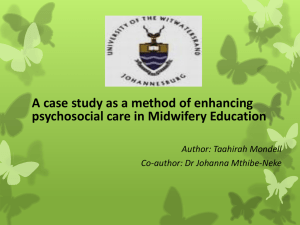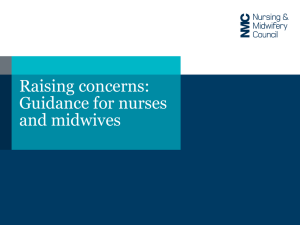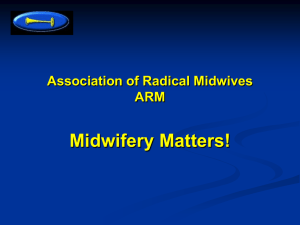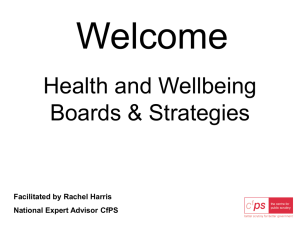Session 17b powerpoint presentation
advertisement
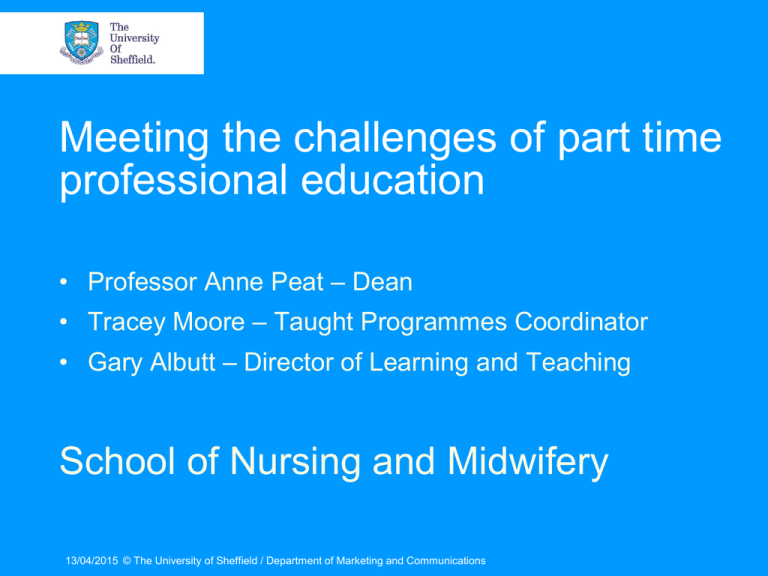
Meeting the challenges of part time professional education • Professor Anne Peat – Dean • Tracey Moore – Taught Programmes Coordinator • Gary Albutt – Director of Learning and Teaching School of Nursing and Midwifery 13/04/2015 © The University of Sheffield / Department of Marketing and Communications Continuing Professional Development – the delivery context • 2011/2012 – 130 accredited modules (available as stand alone study or contributing to award, non accredited short courses and study days) • 600 registered students, 940 study day attendees (93% of student population) • 50% of school income 13/04/2015 © The University of Sheffield / Department of Marketing and Communications Continuing Professional Development – the delivery context • Pattern of student engagement • part time, episodic over 5 years, uncertain outcome • Purpose of student engagement • role development • academic & personal development • personal vs employer intentions 13/04/2015 © The University of Sheffield / Department of Marketing and Communications Continuing Professional Development – the commissioning context • Working better together • service input and influence on provision • Flexibility in commissioning • responsiveness to known and emerging priorities • emphasis on learning events not academic awards • Learning for organisations not individuals • correlation between learning outcomes and service outcomes 13/04/2015 © The University of Sheffield / Department of Marketing and Communications Student and sponsor intentions finding common ground • Return on investment • clear and measurable benefits to practice • determined in what ways and by whom ? 13/04/2015 © The University of Sheffield / Department of Marketing and Communications Return on Investment “ROI measures how effectively the firm uses it’s capital to generate profit” •Firm •Capital •Profit = SHA/Trusts = £ provided to the UoS = Improve patient/client outcome Principles of ROI • It provides a means of accounting for the value of investments in people • It enable learning and development professionals to communicate their value more effectively • It provides a tool for continuous process and performance management • It fixes and extends accountability for investment in the people of an organisation Working with commissioners to demonstrate ROI Level 4 Level 3 Level 2 Level 1 – what impact are the Trusts looking for – how can the impact be measured – how can learning be measured (positive engagement does not necessarily mean learning has occurred) - knowledge of engagement and commitment of commissioners to the development Working example – Chain of Impact Level 4 Need • to recognise and respond to patient deterioration in a more timely and effective manner Objective • to reduce the number of Serious Untoward Incidents by 50% in the first year Level 3 Need • nurses on all wards and clinical areas (excluding ITU and theatres) will comply with the NICE CG 50 guidelines Objectives • nurses will escalate patient EWS triggers as trust protocol • nurses will complete the EWS minimum 12 hourly per patient in each trust area/ward Level 2 Need • deliver education and training in the form of individual study day and supportive pre and post study event web based learning material to all nurses Objectives • to have a 97% pass rate on the post study event web based test and 100% at second attempt • to undertake class based scenarios during the taught day study event supported by facilitators Level 1 • develop the content of the day and supporting web based material and assessment processes with key trust stakeholders including the LBR Lead/SHA and education providers within the trust • 97% of participants recommend this study event to their peers • all participants have the knowledge and skill to perform an ABCDE assessment in 10 minutes • 100% of participants rate the event as highly relevant to their role in reducing SUI’s. Programme for the Preparation of Supervisors of Midwives The University of Sheffield in partnership with the: Yorkshire and the Humber and East Midlands Local Supervising Authorities Midwifery Officers (LSAMO) Professor Anne Peat The purpose of Statutory Supervision To protect the public To support midwives and promote good midwifery practice In fulfilling this remit it plays a critical role in: Developing the profession Ensuring that standards and policies are developed to provide a safe high quality service 13/04/2015 © The University of Sheffield / Department of Marketing and Communications The programme is: 26 week programme equally divided between theory and practice It is delivered at level 6 - Bachelor's degree with honours and level 7 - Master's degree The programme is based on the NMC Standards for the Preparation and Practice of Supervisors of Midwives (NMC 2006) Commissioned by: Yorkshire and The Humber Strategic Health Authority East Midlands Strategic Health Authority who employ the LSAMO 13/04/2015 © The University of Sheffield / Department of Marketing and Communications Enquiry based learning (EBL) EBL enables learning to be in context and concentrates on the skills, knowledge and understanding required to be a supervisor in a particular situation Engel (2001) maintains that EBL assists students to manage unfamiliar situations, make reasoned decisions, reason critically, adapt to and participate in change and manage their own life long learning 13/04/2015 © The University of Sheffield / Department of Marketing and Communications Five steps for EBL include: • Triggers developed to enable students achieve the 4 competencies to become a Supervisor of Midwives as identified in the NMC Standards • In groups ‘trigger tutorials’ the students: identify the facts identify the issues identify the questions allocate the questions • Students search out new knowledge through self study • Fixed resource sessions, adds to the knowledge • Student’s present and feedback to the group. Three formative and one summative assessment 13/04/2015 © The University of Sheffield / Department of Marketing and Communications Course Assessment – 3 elements Element 1 - Seminar presentation (30% weighting) 360˚ assessment, 10% Peer and 20% Academic/LSAMO Element 2 - Written assignment (70% weighting) Element 3 - Competence in Practice Assessment (pass/fail) 13/04/2015 © The University of Sheffield / Department of Marketing and Communications 360˚ Assessment for Trigger feedback • Academic/LSAMO assessment – Most traditional form of assessment • Self assessment – students making judgements about their own work (presentation and performance). It is a formal part of the assessment which is structured and includes an action plan to promote continued development • Peer assessment – students making decisions on other students work, highly effective and encourages collaborative learning. They are excellent predictors of future performance. Names of peers remain confidential. • The feedback from all 3 is collated for individual students 13/04/2015 © The University of Sheffield / Department of Marketing and Communications Impact outcomes: • Prepares midwives to achieve professional competence to undertake the role of the Supervisor of Midwives • The public are protected and midwives are supported to promote good midwifery practice • Prepares midwives to utilise leadership skills • The proportion of midwives subjected to supervisory or Fitness to Practise investigation continues to be very small in comparison to the number of Nurses subject to Fitness to Practise investigation 13/04/2015 © The University of Sheffield / Department of Marketing and Communications

